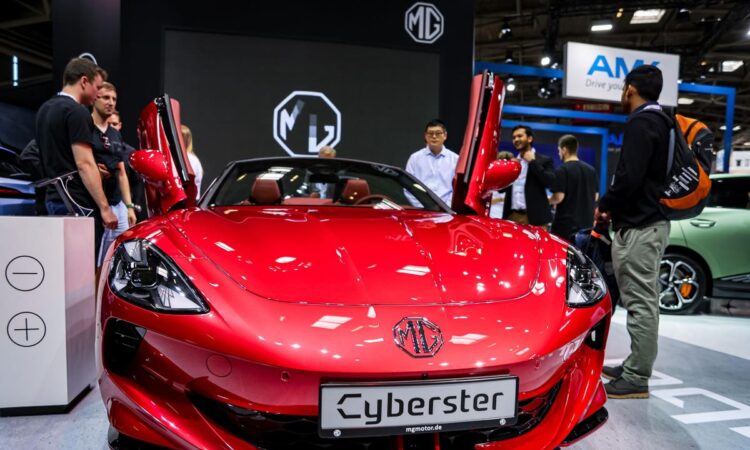
The MG Cyberster electric car at the IAA Mobility 2023 show in Munich, Germany. IAA is runs from … [+]
“There’s many a slip twixt cup and lip” says the old English proverb, or you may prefer “don’t count your chickens before they’re hatched”, but the Chinese auto industry hasn’t yet moved in and shut down the European automotive industry.
In fact, the European industry looks to be in good shape on the surface with sales growth predictions gathering pace, although holding this view requires some strength of character because of the gloom stirred up by news the unstoppable Chinese are coming and we are all doomed.
Last week’s IAA Mobility auto show in Munich provided a relentless backdrop of news about the imminent invasion led by China’s BYD. Build Your Dreams (BYD), Geely, Great Wall Motors and state-owned SAIC brands might eventually pose an existential threat, but that is currently just over the horizon.
Meanwhile, LMC Automotive raised its 2023 sales growth forecast for Western Europe’s sedans and SUVs to 10.7% and 11.23 million, up from 9.4% the month before. That looks less impressive when you compare sales in 2019 of 14.3 million, the year before Covid struck, but it does suggest that when things return to “normal” there’s probably room for everybody, cut price/more efficient Chinese included.
“The macroeconomic environment remains challenging as countries face high interest rates and subdued economic growth. However, with backlogs, and 2022 being a low base, growth remains our core assumption,” LMC said in a statement.
The German economy, Europe’s biggest, is teetering on the brink of recession, although experts don’t expect recovery to be too long delayed. Recently the IMF adjusted its forecast for Germany’s real GDP “growth” in 2023 to minus 0.3% from a previous prediction of minus 0.1%.
S&P Global Mobility expects sedan and SUV sales in Germany to edge slightly higher in 2023 to 2.8 million, up from 2.7 million last year.
In the first half of 2023, European automakers made big profits, and these impressive numbers may come under pressure in the 2nd half as supply chain risks ease and affordability and demand concerns take centre stage, said Germany’s Berenberg Bank. The first signs of Chinese imports may show, but with only a modest impact on bottom lines.
“Average selling prices now seem to be peaking, which combined with numerous demand/affordability red flags, such as inventory rebuilding, competitive pressure, notably from Tesla and growing Chinese imports into Europe, tightening retail credit markets and persisting cost inflations – is testing the sustainability of sector margins,” Berenberg Bank said in a report.
Given the huge recent gains in profitability, Berenberg Bank sees a barely perceptible impact, with manufacturers’ earnings in 2024 and 2025 slipping about an average 5%.
BMW Neue Klasse electric concept at IAA MOBILITY 2023. (Photo by Ren Pengfei/Xinhua via Getty … [+]
First-half financial results showed some mass market players like Renault and Stellantis did well, while Volkswagen struggled, with its electric models worryingly so.
Auto Forecast Solutions is moderately hopeful for European Union sales and expects Germany to accelerate a little in 2024.
“Expected to grow by 14.1%, (sedans and SUVs) sales in the EU demonstrate the region’s on-going recovery from the crash of 2020. Returning above 10 million is important, but the market remains well below the 13 million last seen in 2019. Germany is knocking on 3 million this year but is more likely to crest that mark next year,” Auto Forecast Solutions said in its monthly report.
The European Union consists of 27 states. Western Europe includes the five biggest markets Germany, France, Britain, Italy and Spain.
Investment bank UBS has consistently warned about the danger of Europe’s carmakers easing up on discipline and returning to the old self-defeating stack‘em-high-sell’em-cheap ways, which valued sales above profits. As Europeans increase production and supply chain bottlenecks disappear, price rigor is evaporating.
“The industry is showing little discipline to reduce output in order to keep pricing power high. This will likely become visible in a negative sequential price/mix trend, resulting in higher (manufacturer) revenues but lower margins,” UBS said in a report.
“We expect lower margins in the coming quarters for all (manufacturers) as oversupply becomes more visible. We continue to prefer luxury over premium over mass (market manufacturers) on our expectation of intensifying price competition in the coming quarter,” UBS said.
Renault Megane E-Tech (Photo by Sven Hoppe/picture alliance via Getty Images)
Meanwhile, Europe’s carmakers brace themselves for the first evidence of the real nature of the electric threat from China. Some may be hoping that the initial success of SAIC rests solidly on the name recognition offered by its MG subsidiary. It might be more difficult to sell expensive electric cars with names like Xpeng, Zeekr, BYD, Aiways, Nio, Ora and Maxus, even if they are at least €10,000 ($10,700) cheaper. If that doesn’t work maybe EU tariffs will do the job, or perhaps European manufacturers can raise their collective game and compete on price, quality and battery technology.





